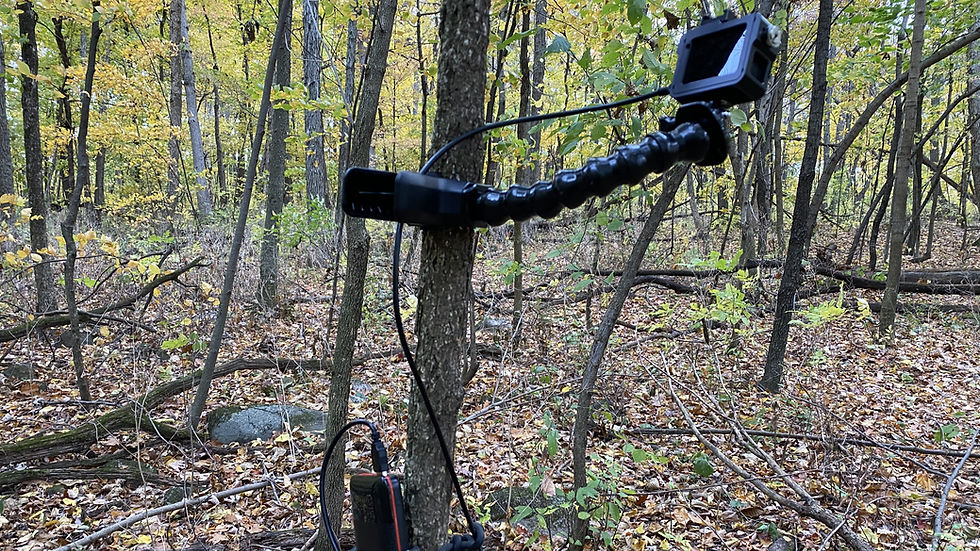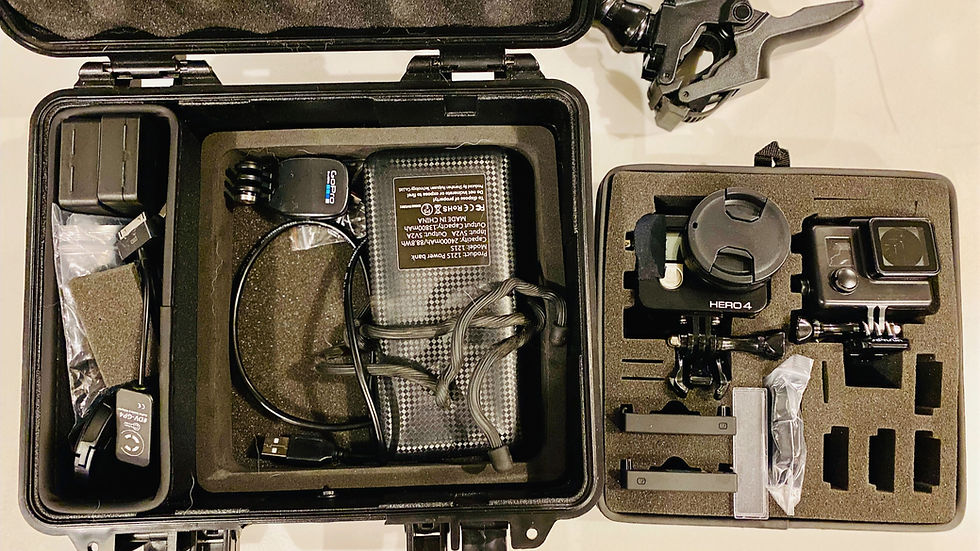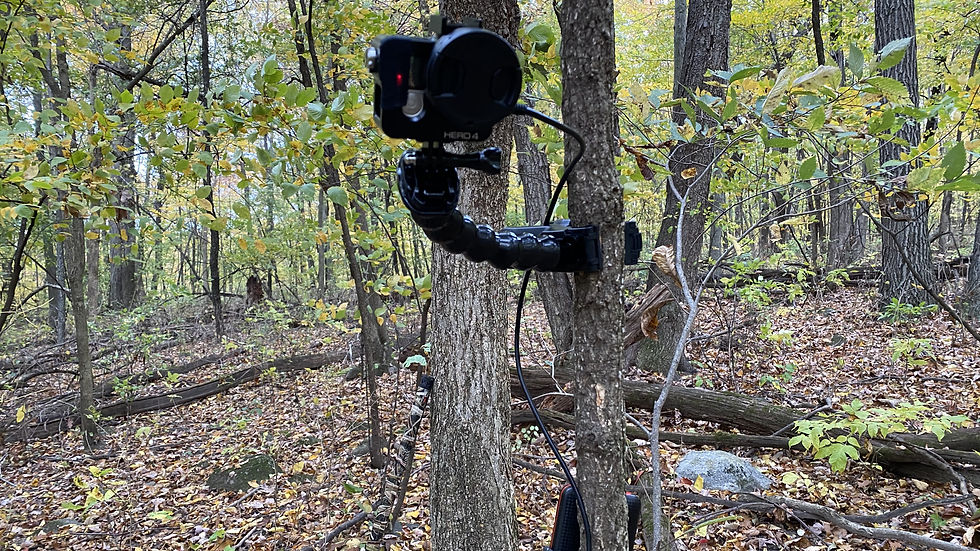Best Camera for Self Filming Hunts, Fishing, and Fly Fishing
- Dustin
- Oct 14, 2020
- 6 min read
Updated: Dec 31, 2020

Learning how to film outdoor adventures can be frustrating, especially if you are learning both the outdoor activity in addition to filming it. So how do you know what the best camera is for self filming hunts, fishing, and fly fishing?
The best camera for self filming hunts, fishing, or fly fishing is an action camera. Action cameras offer the most versatility in an easy to use portable platform. GoPro Hero 8 or 9 offers built-in stabilization and takes stunning quality pictures and video while keeping portability and total cost a priority.What Camera Factors to Consider When Self Filming Hunts, Fishing, and Fly Fishing?
Low light ability. Many hunting and fishing trips will include mornings or evenings where the light will be low and that makes videography and photography tough. Some cameras perform better than others in low light.
Camera lens angle. The angle of the camera lens will determine the size of the frame you are able to capture. The wider or taller the frame, the more action you will capture. However, this may distort peripheral imagery if using a fisheye lens.
Frames per second. The frames per second set on the camera or video device will determine how many mini pictures are recorded per second of time. The higher the frames per second, the more will be captured. However, this also means more data, power, and memory will be used to capture a video.
Portability. Hunting and fishing require you to carry gear around, and filming adds to that carry list. Determine how much weight and space you can carry in addition to your other hunting or fishing gear.
Waterproof. If you are unsure about dunking your camera, you may want to consider a camera that comes waterproof. Self filming hunts and fishing will usually result in contact with rain or bodies of water. Peace of mind for both protection of investment and ability to function at the moment regardless of water may be deciding factors in your purchase.
Shockproof. Everyone drops stuff. Throw in undulating terrain, rocks, stumps, water, and waders and you have more reasons than most to drop your precious cargo. Protection from yourself is always a good idea if it is available.
Image quality. Image quality is the second most important aspect of self filming or documenting your hunting or fishing adventures (the first being content). You want to purchase the best quality camera your budget can afford.
Audio quality. Depending on your application, audio quality may be important. Live streaming, making youtube videos, interviews, or action with interesting audio is just another factor to balance when buying a camera. Some have better internal microphones than others, and most offer the ability to buy external mics and enhance your audio quality.
Budget is the factor that will determine the equipment you purchase to get started. The key is to determine what 90% of your use for the camera will be, then chose a camera that features beneficial specs according to your use and budget.

Self Filming Hunts, Fishing, and Fly Fishing Starter Kit Equipment List
Camera
Microphone(s)
Batteries
Mounts or Tripods
Memory cards
Housing (shockproof, waterproof)
Hard Case for storage
Lens Cleaning (cloth, wipes, etc)
Self Filming Hunts, Fishing, and Fly Fishing Starter Kit
We selected action cameras as our way to get into filming in the outdoors because they are very easy to use and configure while still able to capture high-quality video and acceptable audio content. This setup is also extremely portable and durable which is essential as we learn how to pack and carry film equipment around while hunting and fishing. We also did not want to break the bank trying to learn how to film outdoors, and the quality and application vs cost of an older model action camera was very attractive. The other advantage we liked with the action camera was its functionality while filming solo. Action cameras are not the answer for all scenarios, but they are a great way to get started. There are also more accessories that you can pick up that are not listed, but this is a gear list to save you some money and get you started. You may also need a computer and editing software if you plan to use the content online.
Once you purchase your gear, get it out and practice with it around the house or in the yard. Getting used to the function and options before you get out hunting or fishing can save you precious time and mistakes. It is always a great idea to carry two of everything important to your filming (like memory cards), because if one gets lost or damaged while outdoors, then you can no longer record. Battery backups are great, but the external power source is a better all-day recording solution. Also, you will want to research different recording settings and determine which is best for your application. For real-time quick events like fish striking baits, hook sets, or hunting shots the loop recording feature is fantastic.
What Video Recording Settings to Consider: 1080p vs 4k
1080p is considered high-quality video on all online platforms, TV’s, and monitors
1080p uses less battery than 4k
1080p uses less memory storage
Low-light filming may not be available for both settings
4k is of higher image quality than 1080p
4k can be zoomed in significantly in editing and still produce a focused 1080p quality image
Frames Per Second (FPS)
A higher number of frames produces better slow-motion video (60 fps is a common starting point with 1080p)
Audio
Action cameras typically limited audio quality
External microphone either shotgun or lavalier may help improve quality
Loop Recording
Loop recording is a setting where the camera is always recording but doesn’t save anything to the memory card until you hit the record button. Then it saves the last five minutes (or another chunk of time you set) of the video. This method does take a good bit of battery, but it spares your memory card space while still capturing the high action (unplanned) moments. It is also helpful for editing when you only deal with smaller clips to find the event you want to include.

After using my setup for several hunts I have found a very nice combo that lets me pack a camera set up in both a turkey vest and deer pack without adding much weight or taking up much space. The camera setup is also extremely easy to use and captures close-range action. I have found that with a battery pack, aluminum alloy skeleton housing, flex clamp mount, memory card, Gopro Hero 4 silver refurbished, charging cord (standard USB power cord), and a Nite Ize gear tie I am able to secure the camera and battery pack to just about anything while fishing or hunting and I can record all day without replacing the battery. Using the loop recording video setting allows me to only record the action and not clog up the memory card waiting for something to happen. Below is a table of this setup with amazon links for your convenience. Feel free to shop around for the best price on each item. Last I checked, eBay had the best price on refurbished GoPro Hero 4 Silver cameras and I put a link in the table.
Problems I Ran into My First Time Self Filming Hunts, Fishing, and Fly Fishing
The charging cord on my GoPro Hero 4 is very problematic. It is sensitive to movement and will disconnect if worn on a head mount or chest mount. I did buy it refurbished so I cannot rule out the possibility it was an individual unit problem but judging by the type of connection the power cord utilizes, I think this is a model problem. I was able to use it in a tree stand if the camera cord was not bumped, but it was heavy and bulky compared to the newer camera version.
After using the GoPro Hero 4 for a full season, I picked up a GoPro Hero 8 while it was on sale. The upgraded features are definitely worth the extra money if you can afford it, especially now that the Hero 9 came out they have significantly cut the price on the Hero 8. I was able to run a battery eliminator set up with a thunderbolt charging USB cord on a head strap mount and not have any issues with the power source disconnecting while walking or running. Also, the newer models are inherently waterproof and have a built-in gimble for smoother video stabilization. This allows you to carry around less equipment and get better quality pictures and videos.
Because the GoPro Hero 8 comes factory waterproof and shockproof, I chose to not use a case on it even when running an external power source which slightly compromises the waterproofing.
Filming fishing and hunting requires practice and it is easier if you already have experience in some aspect of filmography or photography. Depending on your activity, filming someone else during your learning process may provide you with valuable lessons that would be hard to learn while filming solo right from the start. Regardless of how you chose to learn, the best way to get proficient is to get outside and start pressing record. There is no substitute for real-world experience, and filmography and photography are no exception. Remember you do not have to spend a bunch of money to learn the basics and still create great content. Grab your gear and get outside!
Comment below with tips on filming outdoors for beginners or on your camera gear setup.




Comentarios